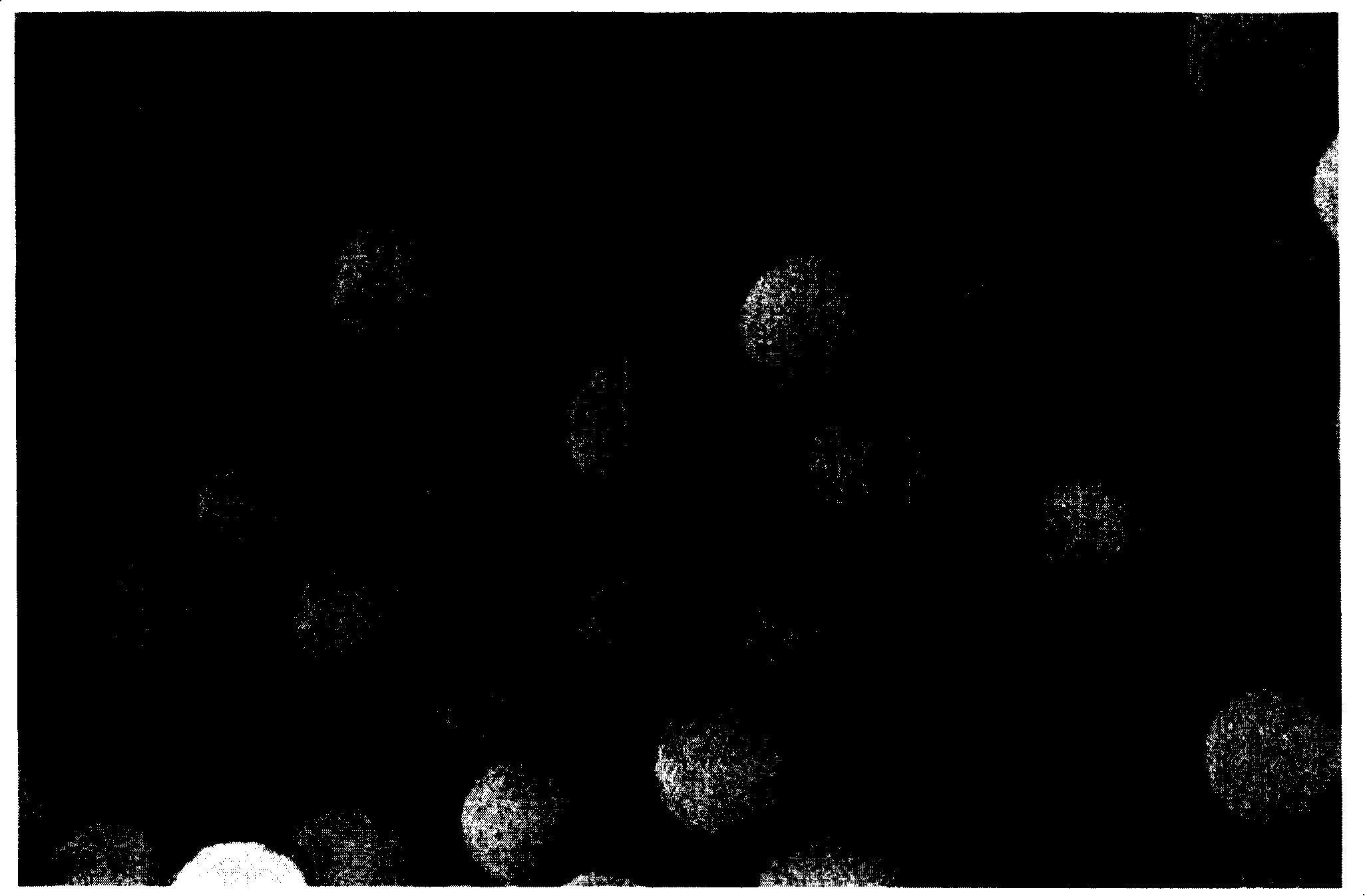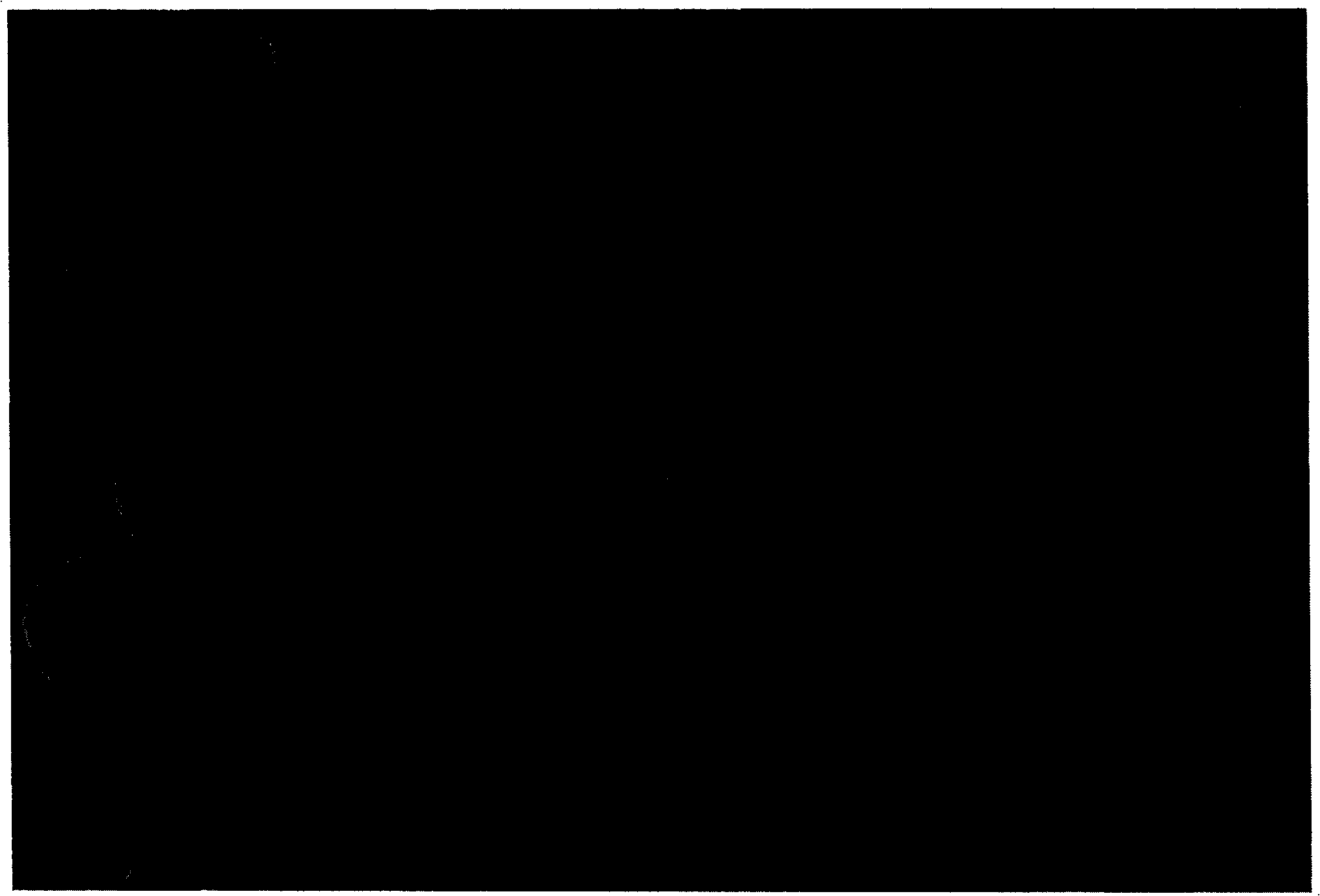Monodisperse high-performance conductive silver particle
A monodisperse and monodisperse technology, applied in liquid chemical plating, coating, metal material coating process, etc., can solve the problems of high price, electromigration, insufficient particle uniformity, etc., and achieve the effect of low cost
- Summary
- Abstract
- Description
- Claims
- Application Information
AI Technical Summary
Problems solved by technology
Method used
Image
Examples
example 1
[0038] Add 1 gram of crystal nucleus particles into 30 ml of sodium dodecyl sulfonate aqueous solution, and ultrasonically disperse it into emulsion a. Put 2 g of chlorododecane into 30 ml of sodium dodecyl sulfonate aqueous solution, and disperse it into emulsion a by ultrasonic For emulsion b, emulsion a and emulsion b were mixed and stirred at 35° C. for 5 hours to obtain emulsion c.
[0039] Dissolve 0.1 g of benzoyl peroxide in 9 g of styrene and 1 g of divinylbenzene, then ultrasonically disperse it in 50 ml of sodium dodecylsulfonate aqueous solution to form emulsion d, mix emulsion c and emulsion d, and heat at 35°C Under stirring for 12 hours, emulsion e was obtained.
[0040] Add polyvinyl alcohol solution to emulsion e to obtain emulsion f. Heat the emulsion f to 70°C for 12 hours to obtain monodisperse microspheres with a certain particle size.
[0041] The obtained polymer microsphere electron micrograph is shown in the attached figure 2 .
[0042] It can be ...
example 2
[0044] Add 1 gram of crystal nucleus particles into 30 ml of sodium dodecyl sulfonate aqueous solution, and ultrasonically disperse it into emulsion a. Put 2 g of chlorododecane into 30 ml of sodium dodecyl sulfonate aqueous solution, and disperse it into emulsion a by ultrasonic For emulsion b, emulsion a and emulsion b were mixed and stirred at 35° C. for 5 hours to obtain emulsion c.
[0045]Dissolve 0.15 g of benzoyl peroxide in 12 g of styrene and 3 g of divinylbenzene, then ultrasonically disperse in 80 ml of sodium dodecylsulfonate aqueous solution to form emulsion d, mix emulsion c and emulsion d, and heat at 35°C Under stirring for 12 hours, emulsion e was obtained.
[0046] Add polyvinyl alcohol solution to emulsion e to obtain emulsion f. Heat the emulsion f to 70°C for 12 hours to obtain monodisperse microspheres with a certain particle size.
[0047] The obtained polymer microsphere electron micrograph is shown in the attached image 3 .
[0048] It can be see...
example 3
[0050] Add 1 gram of crystal nucleus particles into 30 ml of sodium dodecyl sulfonate aqueous solution, and ultrasonically disperse it into emulsion a, put 2 g of chlorododecane into 30 ml of sodium dodecyl sulfonate aqueous solution, and disperse into emulsion a by ultrasonic For emulsion b, emulsion a and emulsion b were mixed and stirred at 35° C. for 5 hours to obtain emulsion c.
[0051] Dissolve 0.25 g of benzoyl peroxide in 20 g of styrene and 5 g of divinylbenzene, then ultrasonically disperse in 150 ml of sodium dodecylsulfonate aqueous solution to form emulsion d, mix emulsion c and emulsion d, and heat at 35°C Under stirring for 12 hours, emulsion e was obtained.
[0052] Add polyvinyl alcohol solution to emulsion e to obtain emulsion f. Heat the emulsion f to 70°C for 12 hours to obtain monodisperse microspheres with a certain particle size.
[0053] The obtained polymer microsphere electron micrograph is shown in the attached Figure 4 .
[0054] It can be see...
PUM
| Property | Measurement | Unit |
|---|---|---|
| Particle size | aaaaa | aaaaa |
| Thickness | aaaaa | aaaaa |
Abstract
Description
Claims
Application Information
 Login to View More
Login to View More - R&D
- Intellectual Property
- Life Sciences
- Materials
- Tech Scout
- Unparalleled Data Quality
- Higher Quality Content
- 60% Fewer Hallucinations
Browse by: Latest US Patents, China's latest patents, Technical Efficacy Thesaurus, Application Domain, Technology Topic, Popular Technical Reports.
© 2025 PatSnap. All rights reserved.Legal|Privacy policy|Modern Slavery Act Transparency Statement|Sitemap|About US| Contact US: help@patsnap.com



